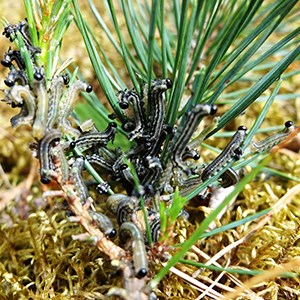Moose and sawflies on the same pine – how do they interact?
By Swedish University of Agricultural Sciences
10/29/2019

Photo Credit: SLU
Although common, indirect interactions between taxonomically distant herbivores, such as mammals and insects, are less studied than interaction between taxonomically related species (insect–insect). In this study the Swedish University of Agricultural Sciences and the Max Planck Institute for chemical ecology in Germany show that sawfly performance was enhanced on trees browsed by moose.
The researchers investigated the effect of moose browsing on Scots pine and subsequent effects on sawfly performance. They reared sawfly larvae on browsed, clipped, and unbrowsed pine trees in a controlled field experiment. Afterward, they measured sawfly cocoon weight. Needle C:N ratio and di‐terpene content were measured in response to browsing.
Sawfly performance was enhanced on trees browsed by moose. Cocoon weight (proxy for fecundity) was 9 and 13 percent higher on browsed and clipped trees compared to unbrowsed trees. Cocoon weight was weakly related to needle C:N ratio, and browsed trees had lower C:N ratio compared to unbrowsed trees. Needle di‐terpene content, known to affect sawfly performance, was neither affected by the browsing treatments nor did it correlate with sawfly weight.
Michelle Nordkvist and her colleagues conclude that mammalian herbivory can affect insect herbivore performance, with potential consequences for ecological communities and with particular importance for insect population dynamics.
The measured plant variables could not fully explain the effect on sawfly performance providing a starting point for the consideration of additional plant responses induced by mammalian browsing affecting insect performance.
Read More: https://www.slu.se/en/ew-news/2019/10/moose-and-sawflie-on-the-same-pine–how-do-they-interact/
Read the international coverage of this article in Frontiers Dispatches: https://esajournals.onlinelibrary.wiley.com/doi/full/10.1002/fee.2103
*The original article is published in Ecology and Evolution.